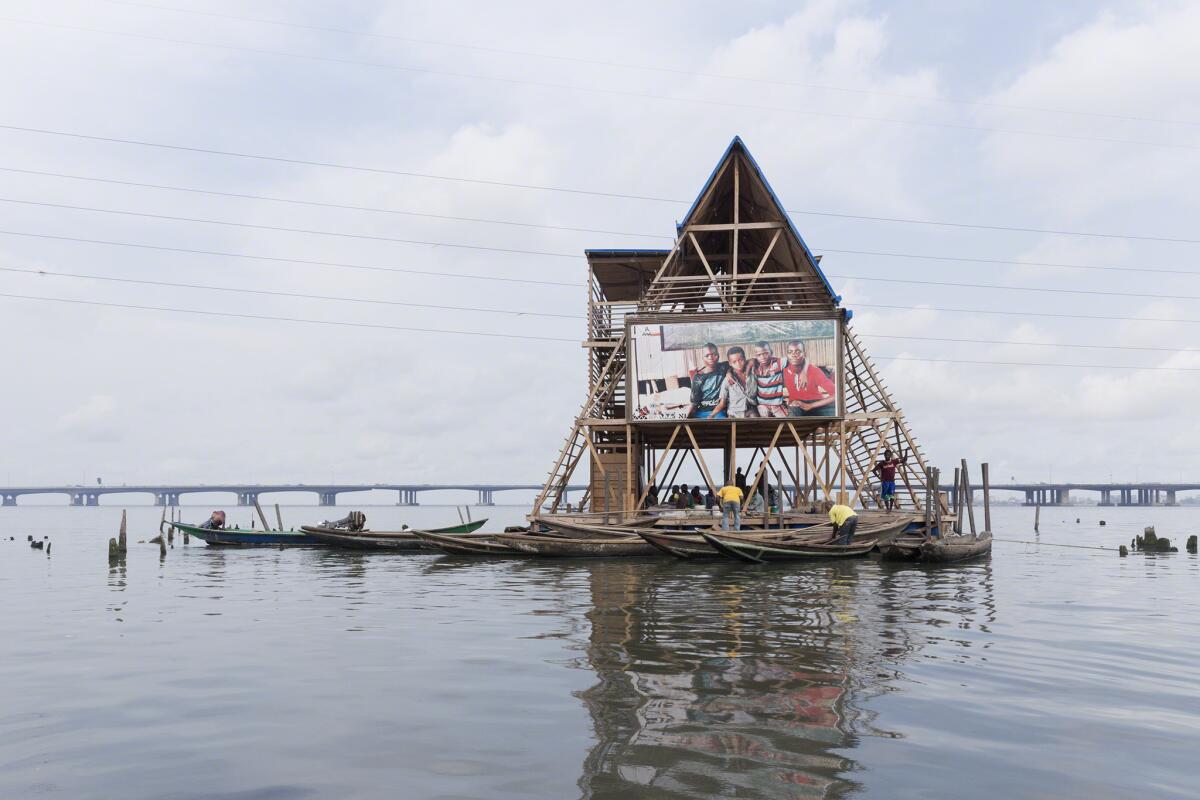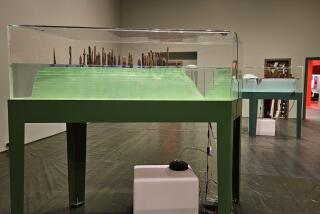‘Sink or Swim’: L.A. photo show looks at how design responds to disaster

An exhibition at the Annenberg Space for Photography documents the ways in which humans are reacting to climate change. Seen here: The Makoko Floating School, by NLÉ architects in Lagos, Nigeria.
Rising tides. Regular floods. Torrential rains. Not to mention the occasional tsunami that can wreak havoc across continents. Roughly 44% of the human population lives within 93 miles of a coast, according to the United Nations Atlas of the Oceans. This represents more people than inhabited the entire planet in 1950. And it is creating an unprecedented challenge for governments, urban planners and architects.
The ways in which coastal communities are contending with change is the subject of a timely exhibition at the Annenberg Space for Photography in Century City. “Sink or Swim: Designing for a Sea Change” brings together archival images along with new, commissioned works to show the myriad ways in which humans are dealing with the influx of water — from low-tech floating villages in Africa to monumental sea walls in Japan.
“The lesson is that we can live smartly with our weather systems and sea patterns,” says curator Frances Anderton. “We can do a combination of the best of contemporary technology with vernacular, defensible adaptations to natural circumstances.”
Anderton, who is host of KCRW’s “Design & Architecture” program, says the idea for the exhibition was born out of patron and board chairperson Wallis Annenberg’s interest in doing an exhibition on architecture with a cause.
“And once we started looking at examples of what we were interested in — buildings from the Make It Right Foundation or Architecture for Humanity,” she explains, “we realized that many of these buildings had something in common: They were responding to catastrophe, incredible storms and rising sea levels.”
The show gathers images by seasoned photographers such as Iwan Baan, Stephen Wilkes, Paul Bronstein, Jonas Bendiksen and Monica Nouwens. These convey the epic damage wrought by natural disasters, such as Hurricane Katrina, which flooded New Orleans in 2005, or the 2011 Tohoku earthquake and tsunami, which led to a nuclear meltdown in Japan. But they also chronicle some of the ingenious solutions developed by individuals and designers in response to the challenge of dealing with climate change: from hurricane-resistant homes in New Orleans to a simple floating school in Nigeria that is buoyed by 250 plastic barrels. (The latter is pictured at the top of this post).
“This is not typical architectural photography that shows a sanitized image of a building that is devoid of humans,” says Anderton. “We wanted an approach that showed the human aspect of architecture. That’s where photographers such as Iwan Baan rose right to the surface. He captures buildings, but he also captures the element of human occupation.”
Naturally, there is plenty in the exhibition to appeal to engineering and urban planning geeks: images of sea walls and displays about the ways in which some cities have begun to develop coastal park areas to serve as natural buffers. But what makes the show more than just a bunch of images for aficionados are the pictures that chronicle the vernacular and low-tech ways in which humans have already adapted to living on water.
Baan’s masterful photographs document a stilt village in Benin that has resided over the shores of Lake Nokoué for centuries, as well as that floating schoolhouse in Nigeria (designed by NLÉ architects). In Bangladesh, Bendiksen captures a system of libraries and schoolhouses on barges operated by Shidhulai Swanirvar Sangstha, a nongovernmental organization.
“There’s a lot of talk in this climate change conversation about mitigation — and that usually involves big ambitious projects with lots of money thrown at them,” says Anderton. “But what you see in these is the exact opposite. It’s people saying that we can’t assume that there will be governmental commitment or resources to do a Netherlands scale of [sea wall] building. So, instead, they come up with other simple and ingenious solutions. There is an elegance to them.”
Also remarkable are the images by Bronstein, which show the post-disaster architecture of Pritzker Prize-winning designer Shigeru Ban, who has devoted a good part of his career to considering the ways in which the needs of refugees can be met with something sturdier than a tent. His designs for post-disaster housing in Japan have included the ingenious use of pre-existing materials, including shipping containers and cardboard tubes.
These low-tech examples provide interesting food for thought, given that efforts to fortify against nature can fail spectacularly.
“Japan has covered some insane amount of coastline in sea walls,” explains Anderton. “They have a highly developed concrete and construction industry. And it seems that after every tsunami, up goes a sea wall. When a wall was built in Kamaishi, people thought it was the sea wall to end all seawalls. But when the tsunami hit in 2011, it crumpled with the first 30-foot wave.”
Making cities more resilient is something that will require urban planners and government officials to think innovatively on very large scales: creating natural buffer zones such as coastal parks and wetlands for their cities and designing buildings that can withstand the occasional storm. (For example: houses with raised foundations in low-lying areas like the U.S. Gulf Coast.)
“It’s a whole ecosystem,” says Anderton. “If there’s something that emanates from this show, it’s that we have to think ecosystematically ... Individual buildings alone are not going to create community-wide resilience.”
And, ultimately, it’s about learning to live with nature, not always fighting it.
“In our own backyard, as we think about the revitalization of the L.A. River, there’s a philosophical change,” says Anderton. “We’ve historically had this philosophy that has been very confident about walling off the river, making massive dams, building massive walls. That was the 20th century way. The 21st century way is to acknowledge the problems without trying to constantly engineer our way out of them.”
“Money and power do not buy you wisdom,” she adds. “There are people out there with incredibly limited resources who are so rich in smarts.”
“Sink or Swim” offers a good opportunity to study what they’re doing, too.
“Sink or Swim: Designing for a Sea Change,” is on view at the Annenberg Space for Photography through May 3. 2000 Avenue of the Stars, Century City, annenbergphotospace.org.
Find me on Twitter @cmonstah.
More to Read
The biggest entertainment stories
Get our big stories about Hollywood, film, television, music, arts, culture and more right in your inbox as soon as they publish.
You may occasionally receive promotional content from the Los Angeles Times.











